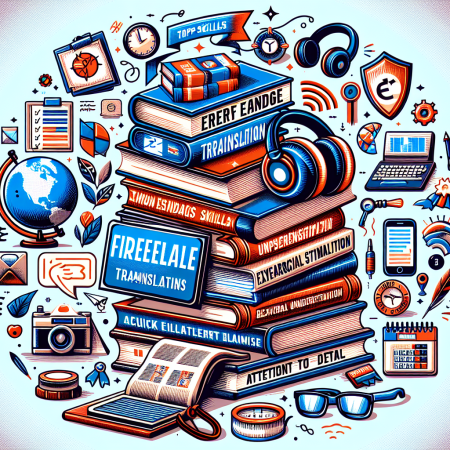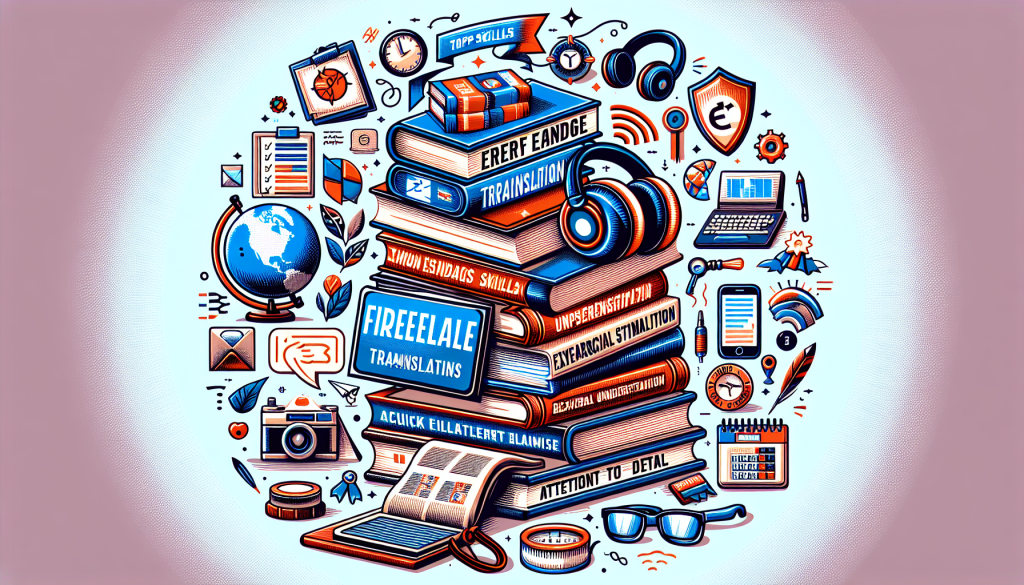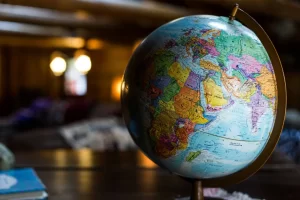Ever since the Tower of Babel, humans have faced language barriers. Today, with globalization shrinking our world, mastering translation skills has become more crucial than ever. Whether it's for bridging cultures or expanding business horizons, the ability to accurately translate between languages is a superpower in our interconnected society. This post dives into the essentials of honing your translation abilities, from understanding cultural nuances to leveraging technology effectively. So, stick around if you're keen on breaking down linguistic walls and enhancing your communication arsenal. We're about to explore how you can elevate your translation game and connect with a broader audience like never before.
Table of Contents
ToggleEssential Translation Skills

Language Proficiency
Mastering both the source and target languages is crucial. It ensures the translated text stays true to the original. This skill involves understanding grammar, vocabulary, and syntax deeply.
Dialects play a big role in translation accuracy. They can change meanings within the same language. So, knowing these nuances helps a lot.
Continuous learning is key in language proficiency. Languages evolve over time. Translators need to keep up with new words and phrases to stay relevant.
Writing Skills
Writing skills are about making sure translated texts are clear, concise, and coherent. This means that readers should understand them easily without any confusion.
Translators must adapt their writing style for different types of content like books, articles, or ads. Each type has its own way of engaging readers.
Proofreading and editing are also important parts of writing skills. They ensure that translations are error-free before they reach the audience.
Cultural Knowledge
Understanding cultural nuances makes translations more accurate and relatable. Idioms often don't have direct equivalents in other languages but knowing how to convey their meaning is a valuable skill.
Being aware of cultural taboos prevents offending your audience unintentionally. Cultural context plays a huge role, too, because it affects how people interpret messages.
Research Skills
Good research skills involve using reliable sources for terminology verification. This is especially important for technical terms which might not be widely known.
Keeping up with linguistic developments helps translators stay informed about changes in language usage. Subject matter expertise is crucial for technical translations because it requires deep knowledge of specific fields.
The Role of a Translator

Translation vs Transcription
Translating written text and transcribing audio are two distinct tasks. Translation involves converting text from one language to another. It requires understanding both languages deeply. Transcription, however, is about writing down what's heard in the same language.
Sometimes, transcription comes before translation. This happens when translating audio or spoken content into another language. Both processes demand high accuracy levels. Mistakes can change meanings completely.
Specialization Areas
Media Localization
Media localization goes beyond simple translation. It adapts content for local cultures and audiences. This includes dubbing movies and subtitling TV shows for international viewers.
Challenges here include capturing the original tone while making it relatable across cultures. Visual elements play a big role, like ensuring graphics fit cultural norms.
SEO Translation
SEO translation makes web content globally accessible through search engines. Good translators know how to weave keywords naturally into their work without losing the message's essence.
This skill boosts global search visibility significantly but requires balancing readability with SEO strategies—a tricky task that demands deep knowledge of both languages involved.
Common Tasks
A translator often works on document translation, website localization, and software translation.
These tasks require strict confidentiality agreements, especially when dealing with sensitive information.
Time management is crucial as projects come with deadlines that must be met.
Developing Translation Skills

Advanced Language Learning
Learning a new language goes beyond just memorizing words and grammar rules. Immersive experiences can boost your skills quickly. For example, watching movies or listening to music in the target language can help. You start understanding not only the language but also the emotions behind words.
Technology plays a big part. Apps and online courses make learning flexible and fun. They offer interactive lessons that fit into your schedule easily.
Being multilingual opens many doors, both personally and professionally. It allows you to connect with more people and understand different viewpoints.
Enhancing Writing
Practice is key to getting better at writing in another language. Try keeping a journal or writing stories. This will improve your fluency over time.
Feedback is crucial for improvement. Ask native speakers or professionals to review your work. They can spot errors you might miss and suggest improvements.
Reading regularly in the target languages sharpens your writing style, too. Books, newspapers, and blogs are great sources of rich vocabulary and complex sentence structures.
Understanding Cultures
Talking with native speakers gives you real insights into their culture. It helps you grasp subtle nuances that are often lost in translation.
Knowing about history enriches your understanding of cultural references found in texts. Travelling or living abroad offers an unmatched depth of cultural understanding.
SEO Content Writing for Translators

SEO Basics
Understanding how search engines work is crucial. They index and rank content based on relevance and authority. This process helps users find the best answers to their questions.
Keyword research is a big part of developing an SEO strategy. It involves finding words people use when they search online. For translators, this means knowing which terms are popular in both the source and target languages.
On-page SEO refers to things you can do on your website to improve its ranking. This includes using keywords in your text, titles, and meta descriptions. Off-page SEO involves actions taken outside of your website, like getting backlinks from other sites.
Both types are important for translators who want their translated content to be found online.
Keyword Integration
Integrating keywords into translated content requires skill. The goal is to make them fit naturally without overdoing it. Too many keywords can make text hard to read, which search engines don't like.
Maintaining keyword density is about balance. A good rule of thumb is 1-2% of your text should be keywords.
Tools like Google's Keyword Planner or SEMrush can help with research and analysis. They show how often people search for specific terms.
Using these tools makes it easier for translators to choose the right words for their translations.
Content Localization
Adapting brand messages for local markets is more than translating words; it's about connecting with people on a cultural level.
Consideration of local customs, values, and humor is essential in creating relevant content.
Legal compliance cannot be overlooked either. Countries have different laws regarding what can be said or shown in advertisements.
Being aware of these regulations ensures that localized content doesn't just resonate but also respects local norms.
Business Skills for Freelancers

Client Communication
Clear communication with clients is crucial. It starts with setting clear project objectives and deliverables upfront. This means freelancers must ask the right questions before beginning a project. Understanding what the client needs helps avoid confusion later.
Handling feedback and requests for revisions professionally is also important. Sometimes, clients may want changes to the work submitted. A freelancer should see this as part of the process, not criticism. Responding promptly and making necessary adjustments shows commitment.
Maintaining professionalism in all interactions keeps relationships strong. Even when disagreements arise, staying courteous can help solve issues faster.
Workflow Management
Effective workflow management separates successful freelancers from those who struggle. Using project management tools can make organizing tasks easier. These tools help track progress on different projects at once.
Setting realistic deadlines is key to managing time well across projects. Overpromising delivery times can lead to rushed work or missed deadlines. Freelancers need to prioritize their tasks, too. They should focus on urgent and complex assignments before moving on to less critical ones.
This approach ensures high-quality work while meeting deadlines.
Professional Image
Building a professional image involves several steps for freelancers:
- Creating a portfolio that showcases diverse translation works.
- Networking at industry events and through online communities increases visibility.
- Gaining professional certifications enhances credibility among potential clients.
A strong portfolio attracts more business by demonstrating capability and versatility in translation skills.
Networking isn't just about attending events; it's also engaging in online forums related to your field. Professional certifications show dedication to one's craft, making a freelancer stand out from competitors.
Career Advancement in Translation
Skills for Resume
Building a strong resume is crucial for advancing your career in translation. It's important to highlight language proficiency levels accurately. Employers look for specific details, so be precise about your fluency in each language.
Including specialized areas of expertise can set you apart. If you excel in legal or medical translations, make sure these are listed on your resume. This shows potential employers that you have the knowledge needed for complex projects.
Listing relevant software proficiency is also key. Familiarity with CAT tools and MS Office demonstrates that you're prepared to tackle translation tasks efficiently. These skills are often required for modern translation work.
Hiring Practices
The demand for translators with niche market knowledge or specific language pairs is increasing. Employers seek professionals who understand the nuances of their target markets.
Assessment tests are becoming a common part of the hiring process. These tests evaluate the quality and speed of your translations, helping employers find the best candidates.
There's also a growing preference for translators familiar with localization practices. Understanding how to adapt content culturally and linguistically is invaluable in today’s global market.
Industry Trends
The use of machine translation has risen sharply but it hasn't replaced human editors; rather, their role has evolved into editing machine-generated texts to ensure accuracy and nuance.
Remote work arrangements have become more prevalent within the industry, offering flexibility and opportunities to work from anywhere.
There's an increasing demand for video game localization services as well. As games reach global audiences, skilled translators play a vital role in adapting content to different cultures while maintaining original context and humor.
Translation Equipment and Tools
Essential Equipment
For any translator aiming to excel, having the right equipment is as crucial as possessing excellent translation skills. A reliable computer with high-speed internet access forms the backbone of a translator's workstation. This isn't just about being able to research and translate but also about accessing and delivering work promptly.
Specialized software tools further elevate a translator’s capability. CAT tools (Computer-Assisted Translation) and DTP software (Desktop Publishing) are not mere accessories; they are necessities that streamline the translation process, ensuring accuracy and consistency across documents. An ergonomic workspace setup cannot be overlooked either. It prevents strain during long hours of work, which can significantly affect productivity and health in the long term.
Imagine sitting in a well-lit room, your hands comfortably resting on an ergonomically designed keyboard, with all necessary tools just a click away. This setup boosts efficiency and makes the job less physically taxing.
Software Utilization
Proficiency with CAT tools does more than just aid in translating text; it enhances overall efficiency by offering features like translation memory and terminology databases. These features ensure that once you've translated a phrase or term, it's stored for future use, saving time when similar phrases appear again.
The advantages of using speech-to-text software for transcription tasks cannot be understated either. It drastically reduces the time spent typing out documents manually, allowing translators to focus more on quality control rather than input speed.
Familiarity with desktop publishing software is another feather in a translator’s cap. Adjusting layouts to accommodate translated text while maintaining original formatting requires skillful manipulation of such software—a task increasingly demanded by clients looking for ready-to-publish files.
Let's take an example: You're working on translating a brochure from English to Spanish; knowing how DTP works means you can adjust text boxes or font sizes directly if Spanish text takes up more space than English due to its longer words or sentences structure.
Challenges in Translation
Numerical Content Management – Accuracy in translating figures, dates, measurements
Translating numbers is not as simple as it seems. Accuracy is key when dealing with figures, dates, and measurements. Different countries have different ways of formatting these elements. For example, some countries use a comma to denote thousands, while others use a period.
A translator must understand these differences. They must convert units of measurement correctly, too. Imagine translating a recipe from the U.S., where ingredients are measured in cups and teaspoons, to a country that uses milliliters and grams. The accuracy of these conversions can affect the outcome dramatically.
Currency conversion is another critical area. A translator needs to know the current exchange rates or at least refer to them accurately within the text if needed. This ensures financial information remains relevant and correct for the reader.
Accuracy vs Fluency – Balancing literal accuracy with natural-sounding translations
Achieving balance between accuracy and fluency is one of translation's biggest challenges. Literal translations often sound awkward or unnatural in the target language. Translators must prioritize context over word-for-word translation.
For instance, idiomatic expressions rarely translate directly well between languages. “It's raining cats and dogs” translated literally into another language might confuse readers unfamiliar with this English expression about heavy rain.
Maintaining the author’s tone and voice adds another layer of complexity. If an original document has a casual tone but gets translated into overly formal language (or vice versa), it could misrepresent the intended message or make readers familiar with both languages. Fluency involves making translations sound natural in their new linguistic home without losing their original meaning or flair.
Translators navigate through complex waters daily by understanding numerical content management and balancing accuracy versus fluency. They ensure messages not only reach across linguistic barriers but also maintain their integrity, contextual relevance, and intended impact on audiences globally. This delicate dance highlights just how vital advanced translation skills are in our increasingly interconnected world.
Closing Thoughts
Navigating the world of translation isn't just about swapping words between languages; it's an art that demands a mix of sharp skills, savvy business acumen, and the right gear. Think of yourself as a linguistic chef, blending flavors of meaning, culture, and context to serve up mouthwatering dishes that resonate across language barriers. From mastering essential translation techniques to tackling SEO content writing and navigating the hurdles of freelancing, you've got a full plate. But remember, with each challenge comes a chance to spice up your career and expand your menu of services.
So, what's your next move? Dive deeper into those skills, experiment with new tools, or maybe even mentor others starting their journey. Whatever path you choose, keep pushing the envelope. Your ability to adapt and grow shapes your success and elevates the translation field as a whole. Ready to turn the page on your next chapter? Let's make words work wonders together.
Frequently Asked Questions
What are the essential skills for a translator?
To be a top-notch translator, you need more than just fluency in languages. Key skills include cultural understanding, writing prowess, and meticulous attention to detail. Think of it as being a linguistic detective with a flair for storytelling.
How does one improve their translation abilities?
Boosting your translation game involves constant learning: immerse yourself in both your source and target languages, practice regularly, and seek feedback from peers. It's like flexing muscles at the gym but with words.
Can SEO content writing benefit translators?
Absolutely! Understanding SEO can make your translations more discoverable online. It's like giving your text a megaphone on the web so that right people can hear its voice loud and clear.
Why are business skills crucial for freelance translators?
Navigating the freelance world requires wearing multiple hats: marketer, accountant, customer service rep… you name it! Sharpening these business skills ensures you're great at translating and running your show successfully.
How can one advance their career in translation?
Career growth means continually honing your craft while expanding into new areas such as localization or specialized fields (medical or legal translation). Networking and certifications can also open doors. Picture climbing a ladder where each rung is an exciting new opportunity.
What equipment do professional translators use?
In this digital age, having reliable software (CAT tools), high-quality headphones for transcription tasks, and ergonomic furniture can make all the difference in efficiency and comfort. Imagine setting up the ultimate craftsman’s workshop where every tool boosts productivity.
What challenges do translators face today?
Translators often juggle tight deadlines, maintaining accuracy across diverse subjects while adapting to evolving language trends. It's akin to balancing on a tightrope while juggling—challenging yet thrilling when done right.






